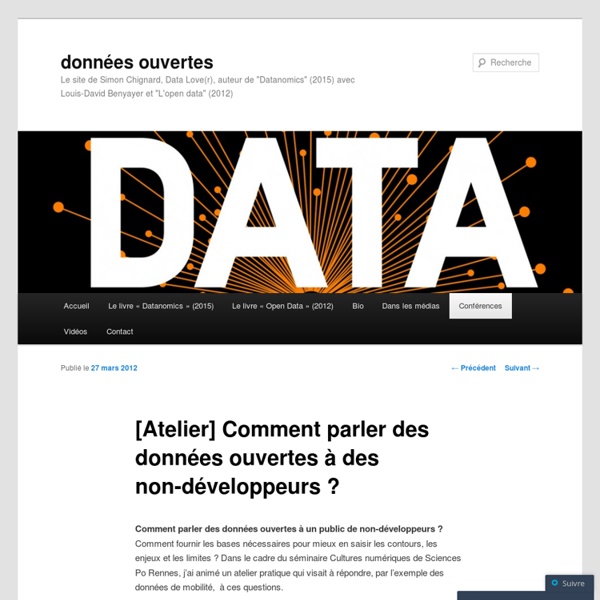Concept de generatedata.com
This data type randomly generates human names (mostly Western) according to the format you specify. You can specify multiple formats by separating them with the pipe (|) character. The following strings will be converted to their random name equivalent: This data type randomly generates names. Whatever text you enter into the options text field will be used to generate telephone numbers. Select one of the values in the example dropdown for some ideas. As with many of the other data types, to generate phone numbers in multiple format separate them with a pipe | character. This Data Type tries to generate a phone number in an appropriate format for the row of data. This data type randomly generates a date between the dates specified, and allows for unique formatting of the result. Day Week Month Year This data type generates a random company name, comprised of a lorem ipsum word and an appropriate suffix, like Dolor Inc., or Convallis Limited. Generates a random zip or postal code.
Federal IT Dashboard
The data feed design tool allows you to select a series of fields to draw from the IT Dashboard database of Exhibits 53 and 300. This dataset is a combination of every agency's Exhibit 53. It includes one row for each investment in the Federal IT Portfolio. Each investment has a Unique Investment Identifier (UII), as well as a collection of spending figures. This dataset is a combination of every agency's Exhibits 300. Select from the available fields on the left and click "Add" to add them to your design. Download as a CSV produces a comma separated values file with a static snapshot of the data.
Daten für alle | Trendreport
Die Open Data Bewegung fordert, dass Daten – nicht nur Zahlen, sondern alle Informationen, die digitalisiert und analysiert werden können – der Allgemeinheit zur freien Verfügung und Weiterverwendung zugänglich gemacht werden. Damit diese Daten genutzt werden können, müssen sie drei Kriterien erfüllen: sie müssen zugänglich (suchbar), standardisiert (z.B. in Form von CSV, Text oder Excel) und wieder verwendbar sein (in dem sie mit offenen Lizensierungen wie Creative Commons geschützt sind). Die Treiber hinter dem Trend Daten für alle sind sowohl technischer, als auch sozio-kultureller Natur. Denn die Verarbeitungskapazitäten für die ständig wachsenden digitalen Inhalte sind exponentiell gestiegen und ermöglichen Zugang nicht nur zu den Endprodukten, sondern auch den Rohdaten. Offene Daten und Transparenz verbessern Politik Im Zuge von Open-Government-Initiativen gehen immer mehr Regierungen dazu über, staatliche Informationen leichter verfügbar zu machen und transparenter zu werden (s.
Dotspotting - Welcome!
données ouvertes | Le site du livre "L'open data, innover avec l'ouverture des données publiques" Simon Chignard, Fyp Editions
Outils
Metadata Composer 26, juillet 2013 | Publié : Outils Dans la lignée de la plateforme Ligne de temps, le MD-composer a été réalisé dans le cadre du partenariat avec le Festival d’Art Lyrique d’Aix en Provence. Lire la suite de l'article HashCut 21, mai 2013 | Publié : Outils Un Hashcut est à la fois une Hypervidéo (vidéo cliquable) et un Mashup (mélange de médias, de l’anglais mash, «purée»). Lire la suite de l'article Renkan 13, mars 2013 | Publié : Outils Renkan (連環, « lien » en Japonais) est un outil de création de cartes heuristiques collaboratives. Lire la suite de l'article Visual Sedimentation js 21, février 2013 | Publié : Outils Qu’est-ce que VisualSedimentation.js ? Lire la suite de l'article Metadata Player 9, mai 2011 | Publié : Outils MetaData Player est spécifiquement conçu pour lire et écrire des métadonnées associées à des contenus audiovisuels diffusés sur le Web. Lire la suite de l'article Polemic Tweet 6, mai 2011 | Publié : Outils Lire la suite de l'article Lignes de temps
Data visualisation : top tools
What data visualisation tools are out there on the web that are easy to use - and free? Here on the Datablog and Datastore we try to do as much as possible using the internet's powerful free options. That may sound a little disingenuous, in that we obviously have access to the Guardian's amazing Graphics and interactive teams for those pieces where we have a little more time - such as this map of public spending (created using Adobe Illustrator) or this Twitter riots interactive. But for our day-to-day work, we often use tools that anyone can - and create graphics that anyone else can too. So, what do we use? Google fusion tables This online database and mapping tool has become our default for producing quick and detailed maps, especially those where you need to zoom in. The main advantage is the flexibility - you can can upload a kml file of regional borders, say - and then merge that with a data table. This excellent tutorial by Google's Kathryn Hurley is a great place to start. Datamarket
Gephi, an open source graph visualization and manipulation software
Un monde de données - des données aux Big Data
L’avenir de l’information : le Web de données À l’occasion d’ICT 2008, la conférence européenne sur les technologies de l’information et de la communication qui s’est tenue à Lyon du 25 au 27 novembre 2008, faisons un retour sur certains des ateliers qui ont ponctué ces trois jours. À quoi ressemblera le monde de l’information demain ? Pour Amanda West de Thomson Reuters, l’agence de presse canadienne spécialisée dans l’information financière, l’information demain sera intelligente. C’est-à-dire qu’elle utilisera des applications sémantiques, des métadonnées pour donner de l’information sur les données, pour aider à structurer ce qui ne l’est pas (structuring the unstructured). Wilfried Runde de la Deutsche Welle est confronté aux mêmes types de difficultés. Selon le Foreign Policy de novembre-décembre 2008 (enregistrement obligatoire), YouTube aura bientôt une plus grande influence mondiale sur la façon de raconter les évènements internationaux que n’importe quel média.



